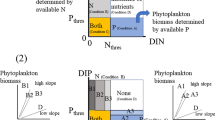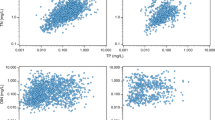Abstract
Nutrient ratios have been related to nutrient limitation of algal growth in lakes. Retention of nutrients in lakes, by sedimentation and by denitrification, reduces the nutrient concentrations in the water column, thereby enhancing nutrient limitation. Differential retention of nitrogen and phosphorus alters their ratios in lakes and thereby contributes to determine whether nitrogen or phosphorus limits algal growth. We examined the relationships between differential nutrient retention, nutrient ratios, and nutrient limitation in Lake Brunner, a deep oligotrophic lake. The observed retention of nitrogen (20%) and phosphorus (47%) agreed with predictions by empirical equations from literature. As a result of differential retention with a much larger proportion of phosphorus retained than that of nitrogen, the nitrogen:phosphorus ratio was higher in the lake (69) than in the inflows (46). While the mean ratio in the inflows suggested no or only moderate phosphorus limitation, the lake appeared to be severely phosphorus limited. Combining empirical equations from literature that predict nitrogen and phosphorus retention suggests that the nitrogen:phosphorus ratio is enhanced by greater retention of phosphorus compared to nitrogen only in deep lakes with relatively short residence times, such as Lake Brunner. In contrast, in most lakes differential retention is expected to result in lower nitrogen:phosphorus ratios.






Similar content being viewed by others
References
Ahlgren, I., T. Frisk & L. Kamp-Nielsen, 1988. Empirical and theoretical models of phosphorus loading, retention and concentration vs. lake trophic state. Hydrobiologia 170: 285–303.
Canfield, D. E. & R. W. Bachmann, 1981. Prediction of total phosphorus concentrations, chlorophyll a, and Secchi depths in natural and artificial lakes. Canadian Journal of Fishery and Aquatic Science 38: 414–423.
Collier, K. J., 1987. Spectrophotometric determination of dissolved organic carbon in some South Island streams and rivers. New Zealand Journal of Marine and Freshwater Research 21: 349–351.
Davies-Colley, R. J. & J. W. Nagels, 2008. Predicting light penetration into river waters. Journal of Geophysics Research 113: G03028. doi:10.1029/2008JG000722.
Davies-Colley, R. J. & W. N. Vant, 1987. Absorption of light by yellow substance in freshwater lakes. Limnology and Oceanography 32: 416–425.
Guildford, S. J. & R. E. Hecky, 2000. Total nitrogen, total phosphorus, and nutrient limitation in lakes and oceans: is there a common relationship? Limnology and Oceanography 45: 1213–1223.
Harrison, J. A., R. J. Maranger, R. B. Alexander, A. E. Giblin, P. A. Jacinthe, E. Mayorga, S. P. Seitzinger, D. J. Sobota & W. M. Wollheim, 2009. The regional and global significance of nitrogen removal in lakes and reservoirs. Biogeochemistry 93: 143–157.
Healey, F. P. & L. L. Hendzel, 1980. Physiological indicators of nutrient deficiency in lake phytoplankton. Canadian Journal of Fishery and Aquatic Science 37: 442–453.
Hecky, R. E., P. Campbell & L. L. Hendzel, 1993. The stoichiometry of carbon, nitrogen, and phosphorus in particulate matter of lakes and oceans. Limnology and Oceanography 38: 709–724.
Morris, D. P. & W. M. Lewis Jr., 1988. Phytoplankton nutrient limitation in Colorado mountain lakes. Freshwater Biology 20(3): 15–327.
Nichol, S. E., M. J. Harvey & I. Boyd, 1997. Ten years of rainfall chemistry in New Zealand. Clean Air 31: 30–37.
Nurnberg, G. K., 1984. The prediction of internal phosphorus load in lakes with anoxic hypolimnia. Limnology and Oceanography 29: 111–124.
OECD, 1982. Eutrophication of Waters: Monitoring, Assessment and Control. Organisation for Economic Co-operation and Development report, Organisation for Economics, Paris, 154 pp.
Paerl, H. W., G. W. Payne, A. L. Mackenzie, P. E. Kellar & M. T. Downes, 1979. Limnology of nine Westland beech forest lakes. New Zealand Journal of Marine and Freshwater Research 13: 47–57.
Saunders, D. L. & J. Kalff, 2001. Nitrogen retention in wetlands, lakes and rivers. Hydrobiologia 443: 205–212.
Schouten, C. J., 1983. Budget of water and its constituents for Lake Taupo (New Zealand). In: Dissolved Loads of Rivers and Surface Water Quantity/Quality Relationships, Vol. 141. International Association of Hydrological Science: 277–297
Seitzinger, S., 1988. Denitrification in freshwater and coastal marine ecosystems: ecological and geochemical significance. Limnology and Oceanography 33: 702–724.
Smith, V. H., 1983. Low nitrogen to phosphorus ratios favor dominance by blue-green algae in lake phytoplankton. Science 221: 669–671.
Verburg, P., 2011. Disentangling effects of eutrophication and CDOM on visual water clarity in Lake Brunner: Preliminary data and methods. NIWA Report HAM2011-009, 36 pp.
Verburg, P., J. Horrox, E. Chaney, J. C. Rutherford, J. M. Quinn, R. J. Wilcock & C. W. Howard-Williams, 2013. Effects of nutrient loading on the trophic state of Lake Brunner. Marine and Freshwater Research 64: 436–446.
Verhoeven, W., R. Hermann, R. Eiden & O. Klemm, 1987. A comparison of the chemical composition of fog and rainwater collected in the Fichtelgebirge, Federal republic of Germany, and from the South Island of New Zealand. Theoretical Applications in Climatology 38: 210–221.
Vincent, W. F., 1983. Phytoplankton production and winter mixing: contrasting effects in two oligotrophic lakes. Journal of Ecology 71: 1–20.
Vollenweider, R. A., 1976. Advances on defining critical loading levels for phosphorus in lake eutrophication. Memorie dell’Istituto Italiano di Idrobiologia 33: 53–83.
Wetzel, R. G., 2001. Limnology, Lake and River Ecosystems, 3rd edition. Academic Press.
White, E., K. Law, G. Payne & S. Pickmere, 1985. Nutrient demand and availability among planktonic communities – an attempt to assess nutrient limitation to plant growth in 12 central volcanic plateau lakes. New Zealand Journal of Marine and Freshwater Research 19: 49–62.
Wilcock, R. J., R. M. Monaghan, R. W. McDowell, P. Verburg, J. Horrox, C. Chagué-Goff, M. J. Duncan, A. Rutherford, G. Zemansky, M. R. Scarsbrook, A. E. Wright-Stow, C. Howard-Williams & S. Cotton, 2013. Managing inputs of nitrogen and phosphorus from pastoral dairy farming to maintain the oligotrophic state of a lake in a high-rainfall catchment. Marine and Freshwater Research 64: 447–459.
Windolf, J., E. Jeppesen, J. P. Jensen & P. Kristensen, 1996. Modelling of seasonal variation in nitrogen retention and in-lake concentration: a four-year mass balance study in 16 shallow Danish lakes. Biogeochemistry 33: 25–44.
Acknowledgments
This study was funded by two Envirolink Grants from the Ministry of Environment (748-WCRC66 and 886-WCRC776) and by Ministry of Business, Innovation and Employment (MOBIE) program C01X1005. We thank Brent Beadle, Jack Grinstead, Casey Beel, and Steffi Henkel for help with data collection. Water samples were analyzed by NIWA water quality laboratory in Christchurch until 2006 and by NIWA Hamilton since then.
Author information
Authors and Affiliations
Corresponding author
Additional information
Handling editor: P. Nõges
Rights and permissions
About this article
Cite this article
Verburg, P., Horrox, J., Chaney, E. et al. Nutrient ratios, differential retention, and the effect on nutrient limitation in a deep oligotrophic lake. Hydrobiologia 718, 119–130 (2013). https://doi.org/10.1007/s10750-013-1609-3
Received:
Revised:
Accepted:
Published:
Issue Date:
DOI: https://doi.org/10.1007/s10750-013-1609-3




